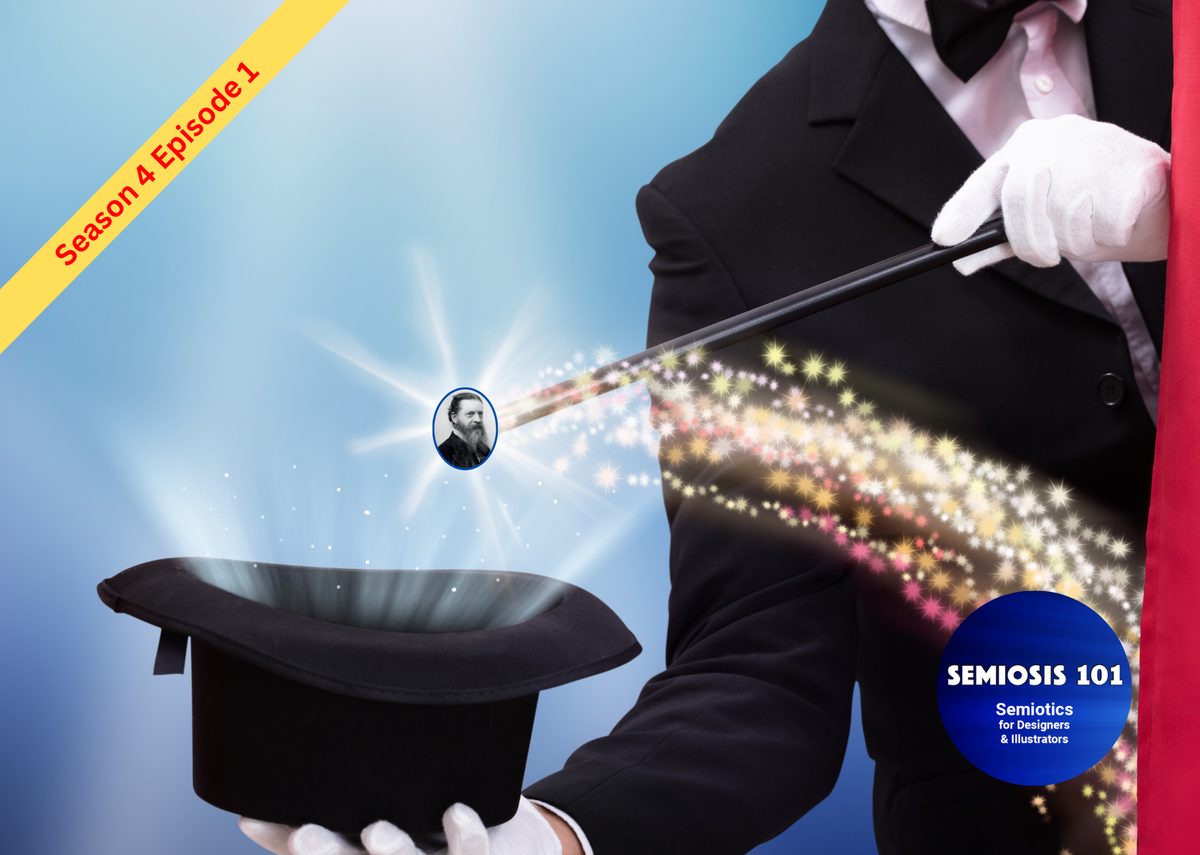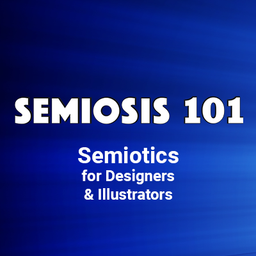Free Semiosis 101 Transcript 4.1:

How do CREATIVES visually communicate …THIS*?
Hello readers.
In this free transcript for the episode published on Semiosis 101 on Wednesday 5th March 2025 we ask the question How do CREATIVES visually communicate …THIS*?
(The THIS in this question being whatever you need to visually communicate).
The moment you begin to visualise ideas, the marks you make, however crude, are already meaning-bearing. That meaning then matures as the design or illustration develops. As creatives, meaning is visually communicated whether you intend it or not.
This is how sophisticated and rich creative outputs can visually communicate at different levels. It is also how miscommunication can happen. Let us now turn to the moment when your visual language semiotically turns from dormant to active interpretation.
Watch the free video on YouTube for the full impact…
…and here is the episode’s transcript.
How Do CREATIVES Visually Communicate …THIS*?
(The THIS*? in this question being whatever you need to visually communicate).
Our first question out of season four’s 20 questions quickly contextualises Charles Sanders Peirce’s semiotic theory of Semiosis. Semiosis is a theoretical strategy for applying semiotic signs to enhance visual communication in your creative practice.
Let us jump straight in to develop your semiotic frame of minds with sign-action.
Straight away, in the 1st episode of Semiosis 101’s season four, we are attempting something seismic. You are aware of the trick of whipping away a table cloth while the plates, cups and cutlery stay in place, yes? Well, that is metaphorically what Semiosis 101 intends to do for you designers and illustrators this season.
I will be revealing a semiotic frame of mind to you all, whilst you keep your existing creative process in place. This is more than a sleight of hand on my part, for me to show how Charles Sanders Peirce’s semiotic theory of Semiosis maps to your existing creative process. Semiosis ENHANCES how you visually communicate to audiences. This all begins very early on during what I will call your ideation phase. You may just call this sketching!
So as illustrators and designers, you all produce outcomes that visually communicate something to someone. You all learnt your skillsets and apply them with each new job. Some of you learnt these skills at design and art school. Applying semiotics is not relearning what you know.
On Semiosis 101 I focus on enhancing your skillsets WITH designer-centric knowledge of semiotic sign-action. Charles Sanders Peirce names this Semiosis. As creatives, you have your own creative process established (if you are a professional) or you are still developing one. You may each use different media which is great, but what unites you all is that you are all visual communicators.
The moment you begin to visualise ideas, the marks you make, however crude, are already meaning-bearing. That meaning then matures as the design or illustration develops. As creatives, meaning is visually communicated whether you intend it or not. This is how sophisticated and rich creative outputs can visually communicate at different levels.
It is also how miscommunication can happen.
Every designer and illustrator has been working semiotically, but you have been doing this tacitly, instinctively, and more than likely …blindly. Semiosis, is a Pragmatic semiotic theory predicated on (at a macro level) what the client needs to be communicated, how the creative renders this …AND how the target audience perceives and understands this. We visually communicate in essentially two ways:
• Denotatively - THIS means THIS
• Connotatively - THIS means THAT now
Semiosis is the semiotic framework where you can move from an obvious meaning to sophisticated messaging. At a micro level, Semiosis enhances your visual language to hook and retain audience attention. Semiotic sign-action at a micro level, in designer-centric terms follows a determination flow of concept > representation > interpretation. Peirce’s original terms are more obtuse than that.
The designer’s or illustrator’s role is to visually communicate the message (concept) through how they design or illustrate (representation). However, the interpretation is in the hands of the audience. Meanings and messaging are always more than simply denotative.
In Visual Communication Design, you designers and illustrators are dealing with subtleties of tone of voice, emotional connections and creating the correct vibe for the subject and audience. You naturally visually communicate connotatively. Applying a semiotic structure to your connotative approach, helps you to craft the most effective visual meaning-bearing elements in your designs or illustrations.
Peirce’s semiotic sign-action provides you with ways to visually calibrate the communication of deeper meanings. Do you remember that Peirce says that nothing is a semiotic sign until it is interpreted? Every mark you make has the potential to be meaning-bearing. It is dormant until perceived as meaning something. This is how the visual language you choose, can be enhanced to convey what is meant to be visually communicated (the concept). Or it can miscommunicate.
Semiosis can begin at the simplest level with mere qualities as semiotic signs to trigger the perception process. Let us now turn to the moment your visual language can semiotically turn from dormant to active interpretation. Hopefully you have understood that your crafting of the visual language you use in your illustrations or designs is already semiotically rich?
By applying Semiosis, you can control how that visual language makes stronger connections with your audience. Obviously, Peirce never wrote his theory with designers and illustrators in mind. Therefore, his writing and terminology is very obtuse and needs heavy contextualisation. That is why Semiosis 101 exists. In Peirce’s Semiosis, there is a triadic determination flow between three states:
• what needs to be communicated (concept)
• how it is semiotically conveyed (representation)
• how this is perceived by the audience (interpretation)
Triads (threes) are central to this flow. These inter-connected states ensures that semiotic sign-action is powered, even in the weakest semiotic signs of mere qualities. Each of these three states are in turn individually powered by an internal triad (e.g. Iconic, Indexical and Symbolic representation levels) from simple to complex.
Peirce defines ten sign-classes, from simple to complex, which explain how something can be semiotically communicated. Check out my season 3 episodes. The powering of these semiotic signs can be summarised, in designer-centric terms, as the result of how a sign’s meaning-bearing capabilities are perceived, represented and delivered. A semiotic sign for something can therefore be perceived, represented and delivered by manipulating the intensity of each of these capabilities.
If you want to visually communicate THIS* (*insert whatever you need here*), you can control how your audience will perceive, represent or deliver THIS* in your designs or illustrations. If you want to read more about these power levels, check out my Semiosis 101 Semiotic Resource on Semiosis101.online. Link is below in the description.
To effectively visually communicate THIS* in your creative work to your target audience is not laborious nor magic. Semiosis’ triads help you to proactively connect with your audience. I will now summarise how.
Peirce’s theory of semiotics comes from a Pragmatic philosophical ground, rather than Saussure’s Structuralist linguistic form of semiotics. Peirce’s Semiosis is rooted within Phenomenology, and this helps creatives to focus on how you can connect with your audiences. If visual communication, as framed within a Pragmatic semiotic lens, crafts its visual language of marks, colours, qualities to convey meaning; then Semiosis has an actionable framework to enhance its success.
For any audience to understand what they see, they interpret meaning from the visuals. Meaning is dormant until perceived, but this perceptual change is in the audience. The design or illustration has not changed in any way.The visual language has just triggered a change in the mind of the audience. This was That. Now This is THIS OTHER THING.* Semiosis’ semiotic sign action begins…
As designers and illustrators you create. What and how you create your work, at a micro level is the layering of simple qualities, to form more complex designs and illustrations. A brush stroke can indicate a tree, the wind, a nose, etc. A swoosh could form a glyph, a graphic, a logo, etc. These weak and ephemeral qualities are your semiotic micro-level visual communication building blocks of meaning. They form what Peirce calls Qualisigns, one-off meaning-bearing triggers. Qualisigns are fleeting.
Qualisigns help break the dormancy of perception, through contextual familiar possibilities. The quality (e.g. redness) in itself will always be weakly meaning-bearing, until more can be interpreted. Only Peirce’s class one signs are Qualisigns. Once triggered, these class one signs instantly (and subconsciously) move the audience to class two of semiotic signs.
So how do we visually communicate THIS*?
(* The THIS in this question being whatever you need to visually communicate).
Firstly, we visually communicate THIS* from weak semiotic qualities that are possibly familiar to your audience. Deeper meaning lies dormant in plain sight in your designs and illustrations. If the audience can be contextually guided, then these qualities can instantly become the perceptual triggers for the audience.
Secondly, once a semiotic quality piques audience interest, then they can begin to interpret more subtle concepts from the representations within your crafted visual language.
We will expand on this in the next episode.
So subscribe to be notified when this next free episode is published. Or become a Semiosis 101 Producer on Patreon and watch all future episodes months ahead of YouTube …plus exclusive goodies.
Hint… hint…
Semiosis 101 Semiotic Design Resources is a reader-supported publication. To receive exclusive posts and support my work, consider becoming a free or paid subscriber. Paid subscribers get name checked on all future Semiosis 101 YouTube episodes.
===Semiosis 101 Patreon Producer==============
Become a Semiosis 101 Patreon Producer and get a named producer credit on future video episodes, plus watch all new episodes months ahead of YouTube.
===Semiosis 101 Patreon Exclusives==============
Watch longer Patreon-exclusive Semiosis 101 episodes on applying Semiosis into design and illustration…
PATEXC001 How does semiotics work in illustration?





